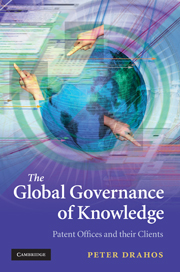Book contents
- Frontmatter
- Contents
- List of diagrams and tables
- List of abbreviations
- Preface
- 1 Patent offices and the global governance of knowledge
- 2 Labyrinths and catacombs: Patent office procedure
- 3 The rise of patent offices
- 4 The Sun and its planets: The European Patent Office and national offices
- 5 The USPTO and JPO
- 6 The age of Trilaterals and the spirit of cooperation
- 7 The jewel in the crown: India's Patent Office
- 8 The dragon and the tiger: China and South Korea
- 9 Joining the patent office conga line: Brazil
- 10 Islands and regions in the patent stream
- 11 Reclaiming the patent social contract
- 12 Patent administration sovereignty: Nodal solutions for small countries, developing countries
- Index
- References
11 - Reclaiming the patent social contract
Published online by Cambridge University Press: 03 May 2010
- Frontmatter
- Contents
- List of diagrams and tables
- List of abbreviations
- Preface
- 1 Patent offices and the global governance of knowledge
- 2 Labyrinths and catacombs: Patent office procedure
- 3 The rise of patent offices
- 4 The Sun and its planets: The European Patent Office and national offices
- 5 The USPTO and JPO
- 6 The age of Trilaterals and the spirit of cooperation
- 7 The jewel in the crown: India's Patent Office
- 8 The dragon and the tiger: China and South Korea
- 9 Joining the patent office conga line: Brazil
- 10 Islands and regions in the patent stream
- 11 Reclaiming the patent social contract
- 12 Patent administration sovereignty: Nodal solutions for small countries, developing countries
- Index
- References
Summary
A private insider governance network
The twentieth century proved to be the century of innovation in patent bureaucracy and the regulation of markets by patent owners using patenting strategies. Whether this staggering global growth in patent bureaucracy and patent regulation of markets actually caused much important scientific and technological innovation that would otherwise not have occurred, and at a cost that did not outweigh the benefits, is a question to which we will probably never have an answer. More often than not, analysis of the patent system begins with a presumption in its favour: ‘High levels of innovation in the United States would seem to be evidence that the intellectual property system is working well and does not require fundamental changes.’
At the beginning of the nineteenth century few European states had patent law and none had recognizably modern systems of patent administration (see Chapter 3). At the beginning of the twenty-first century it is hard to find an example of a country that does not have a patent law of some kind on the books – Timor Leste is perhaps one example. Even in some of the poorest, smallest states such as some of the Pacific islands, there are patent laws on the books that technically, as we saw in Chapter 10, form part of global patent filing routes. No island seems to be without a patent law.
- Type
- Chapter
- Information
- The Global Governance of KnowledgePatent Offices and their Clients, pp. 285 - 317Publisher: Cambridge University PressPrint publication year: 2010
References
- 1
- Cited by



